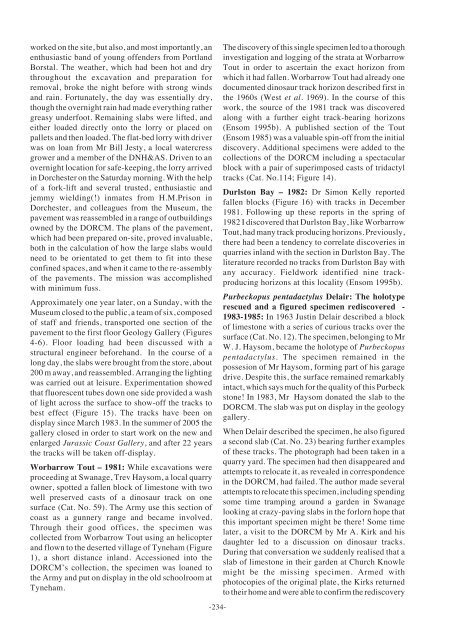Continental trace fossils and museum exhibits - Geological Curators ...
Continental trace fossils and museum exhibits - Geological Curators ...
Continental trace fossils and museum exhibits - Geological Curators ...
You also want an ePaper? Increase the reach of your titles
YUMPU automatically turns print PDFs into web optimized ePapers that Google loves.
worked on the site, but also, <strong>and</strong> most importantly, anenthusiastic b<strong>and</strong> of young offenders from Portl<strong>and</strong>Borstal. The weather, which had been hot <strong>and</strong> drythroughout the excavation <strong>and</strong> preparation forremoval, broke the night before with strong winds<strong>and</strong> rain. Fortunately, the day was essentially dry,though the overnight rain had made everything rathergreasy underfoot. Remaining slabs were lifted, <strong>and</strong>either loaded directly onto the lorry or placed onpallets <strong>and</strong> then loaded. The flat-bed lorry with driverwas on loan from Mr Bill Jesty, a local watercressgrower <strong>and</strong> a member of the DNH&AS. Driven to anovernight location for safe-keeping, the lorry arrivedin Dorchester on the Saturday morning. With the helpof a fork-lift <strong>and</strong> several trusted, enthusiastic <strong>and</strong>jemmy wielding(!) inmates from H.M.Prison inDorchester, <strong>and</strong> colleagues from the Museum, thepavement was reassembled in a range of outbuildingsowned by the DORCM. The plans of the pavement,which had been prepared on-site, proved invaluable,both in the calculation of how the large slabs wouldneed to be orientated to get them to fit into theseconfined spaces, <strong>and</strong> when it came to the re-assemblyof the pavements. The mission was accomplishedwith minimum fuss.Approximately one year later, on a Sunday, with theMuseum closed to the public, a team of six, composedof staff <strong>and</strong> friends, transported one section of thepavement to the first floor Geology Gallery (Figures4-6). Floor loading had been discussed with astructural engineer beforeh<strong>and</strong>. In the course of along day, the slabs were brought from the store, about200 m away, <strong>and</strong> reassembled. Arranging the lightingwas carried out at leisure. Experimentation showedthat fluorescent tubes down one side provided a washof light across the surface to show-off the tracks tobest effect (Figure 15). The tracks have been ondisplay since March 1983. In the summer of 2005 thegallery closed in order to start work on the new <strong>and</strong>enlarged Jurassic Coast Gallery, <strong>and</strong> after 22 yearsthe tracks will be taken off-display.Worbarrow Tout – 1981: While excavations wereproceeding at Swanage, Trev Haysom, a local quarryowner, spotted a fallen block of limestone with twowell preserved casts of a dinosaur track on onesurface (Cat. No. 59). The Army use this section ofcoast as a gunnery range <strong>and</strong> became involved.Through their good offices, the specimen wascollected from Worbarrow Tout using an helicopter<strong>and</strong> flown to the deserted village of Tyneham (Figure1), a short distance inl<strong>and</strong>. Accessioned into theDORCM’s collection, the specimen was loaned tothe Army <strong>and</strong> put on display in the old schoolroom atTyneham.-234-The discovery of this single specimen led to a thoroughinvestigation <strong>and</strong> logging of the strata at WorbarrowTout in order to ascertain the exact horizon fromwhich it had fallen. Worbarrow Tout had already onedocumented dinosaur track horizon described first inthe 1960s (West et al. 1969). In the course of thiswork, the source of the 1981 track was discoveredalong with a further eight track-bearing horizons(Ensom 1995b). A published section of the Tout(Ensom 1985) was a valuable spin-off from the initialdiscovery. Additional specimens were added to thecollections of the DORCM including a spectacularblock with a pair of superimposed casts of tridactyltracks (Cat. No.114; Figure 14).Durlston Bay – 1982: Dr Simon Kelly reportedfallen blocks (Figure 16) with tracks in December1981. Following up these reports in the spring of1982 I discovered that Durlston Bay, like WorbarrowTout, had many track producing horizons. Previously,there had been a tendency to correlate discoveries inquarries inl<strong>and</strong> with the section in Durlston Bay. Theliterature recorded no tracks from Durlston Bay withany accuracy. Fieldwork identified nine trackproducinghorizons at this locality (Ensom 1995b).Purbeckopus pentadactylus Delair: The holotyperescued <strong>and</strong> a figured specimen rediscovered -1983-1985: In 1963 Justin Delair described a blockof limestone with a series of curious tracks over thesurface (Cat. No. 12). The specimen, belonging to MrW. J. Haysom, became the holotype of Purbeckopuspentadactylus. The specimen remained in thepossesion of Mr Haysom, forming part of his garagedrive. Despite this, the surface remained remarkablyintact, which says much for the quality of this Purbeckstone! In 1983, Mr Haysom donated the slab to theDORCM. The slab was put on display in the geologygallery.When Delair described the specimen, he also figureda second slab (Cat. No. 23) bearing further examplesof these tracks. The photograph had been taken in aquarry yard. The specimen had then disappeared <strong>and</strong>attempts to relocate it, as revealed in correspondencein the DORCM, had failed. The author made severalattempts to relocate this specimen, including spendingsome time tramping around a garden in Swanagelooking at crazy-paving slabs in the forlorn hope thatthis important specimen might be there! Some timelater, a visit to the DORCM by Mr A. Kirk <strong>and</strong> hisdaughter led to a discussion on dinosaur tracks.During that conversation we suddenly realised that aslab of limestone in their garden at Church Knowlemight be the missing specimen. Armed withphotocopies of the original plate, the Kirks returnedto their home <strong>and</strong> were able to confirm the rediscovery
















